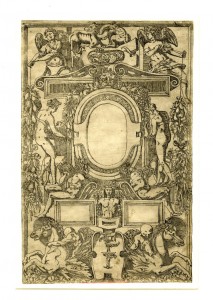Vertical Cartouche with Putti Below Riding Winged Horses Framing a Small Blank Oval
After Rosso?
Etching by Antonio Fantuzzi, 38 x 24.7 S (London).
Bartsch and Herbet recognized Fantuzzi’s monogram in the small dark space beneath the torso of the herm, where the AF does seem to appear. To Zerner these lines are merely part of the shading.
Fig.E.82 (London)
Bartsch, XVI, 1818, 354, 37, as Fantuzzi. Herbet, II, 1896, 271 (1969, 67), 8, as Fantuzzi. Zerner, 1969, A.F.51 (Vienna), as 1542-1543.
COLLECTIONS: Berlin, 959-19. London, 1850-5-27-225. Paris, Eb 14d. Vienna, Vol. XIII, 2, p.78, no. 446.
LITERATURE:
Berliner, 1925-1926, I, Pl. 116, Text Volume, 41.
Kusenberg, 1931, 166, as Fantuzzi, in the style of Rosso, and perhaps after a lost decoration at Fontainebleau.
Béguin, RdA, 1969, 105, indicates the importance of the design because of the two salamanders and the Royal F.
Zerner, IB, 33, 1979, 256 (London).
As pointed out by Béguin, the appearance of the two salamanders, with their necks entwined, at the top of this cartouche, and the Royal F below give special importance to this design. On the possibility that this cartouche is related to the decoration that Rosso may have invented for the Small Gallery at Fontainebleau, see L.41. Stylistically, the figures in this cartouche resemble in their form and emotion those of the frame of the Petrarch drawing of around 1534 at Christ Church (Fig.D.47a). The size and multiplicity of the human, vegetal, and architectural forms are similar to those that appear in Fantuzzi’s etching that is related to the frames of the frescoes in the Pavilion of Pomona of 1532 or 1533 (Fig.E.63). It is also similar to the parts of the Gallery of Francis I that were designed early, such as the Loss of Perpetual Youth and its flanking stuccoes and frescoes (Fig.P.22, II S a). The cartouche could have been designed around 1533 or 1534.
It is, of course, impossible to insist that this cartouche was designed by Rosso, but it has about it a richness, elegance, and vivacity that strongly suggest him. If not by Rosso, then one would have to believe it was by Fantuzzi himself, or by Thiry or some other assistant of Rosso’s working with his vocabulary. But it does not seem like a pastiche and does not seem like the Fantuzzi we know from the slight ways he alters Rosso’s designs in those cases in which drawings used as the etcher’s models survive (see the Pandora and Her Box, Fig.D.67a and Fig.E.79a). Thiry’s style is known from various prints by Boyvin, and while this cartouche looks generically like some of his designs, Thiry’s Rossoesque style is always somewhat more naturalistic on the one hand and more caricatural on the other. While the negation of Fantuzzi and Thiry does not prove Rosso’s authorship, one is hard put to imagine someone else on the Fontainebleau scene capable of such an imaginative invention, unless one considers Primaticcio. On the basis of style, his authorship of this panel is not possible to defend. The only other artist that comes to mind is Nicolas Belin da Modena, but what is thus far known about him does not allow for the attribution of the design of this print to him. It may be that Rosso is the inventor of this cartouche working in a somewhat miniaturistic mode. If designed by Rosso, Fantuzzi would most probably have worked from a drawing by him, in the opposite direction. That drawing could have looked something like the Petrarch drawing at Christ Church.
COPIES, PRINTS: E.56,5. Du Cerceau, etching. Herbet, IV, 1900, 302 (1969, 152), V (Grands Cartouches, Second Set), 5.
E.57,7. Du Cerceau, etching. Herbet, IV, 1900, 306 (1969, 156), VI (Petits Cartouches), 20. Copied with small additions and variations, but in the same direction, except for the Royal F that is reversed.
The left half of the cartouche, without the reclining nude youth and with other simplifications, was used doubled and in reverse at the right to form the cartouche that frames Charles IX’s Pietate et justitia device in G. Ruscelli, Le Imprese illustri, 1580 (Russell, 1985, Fig. 15).

